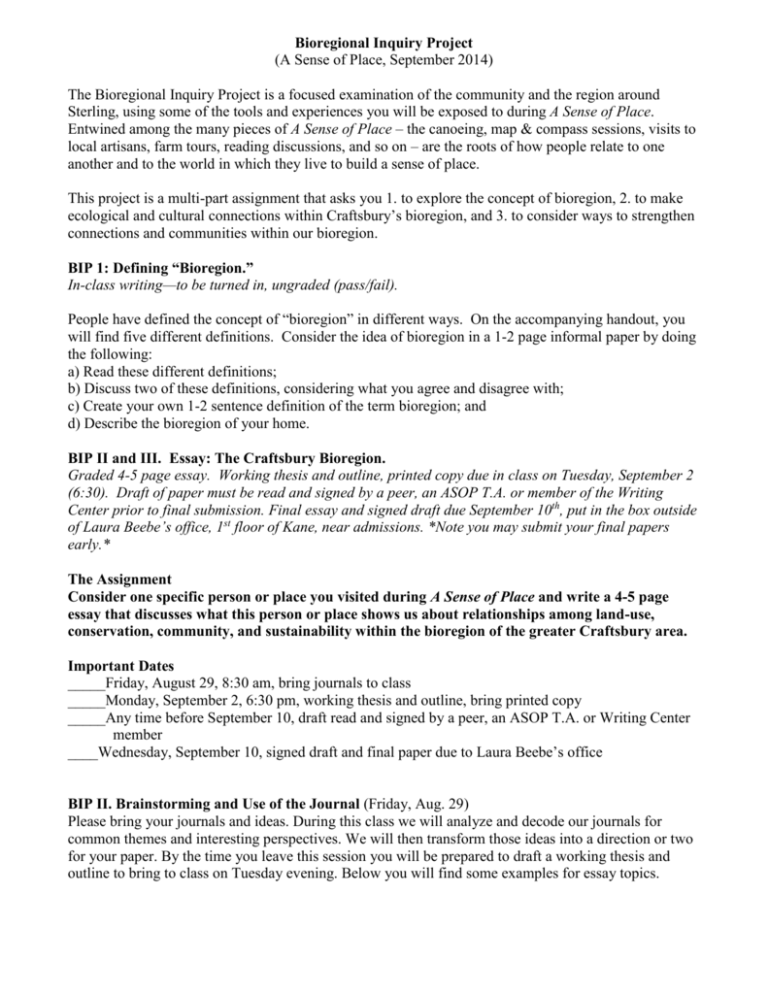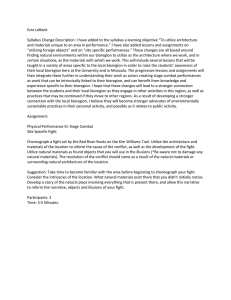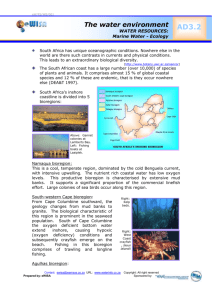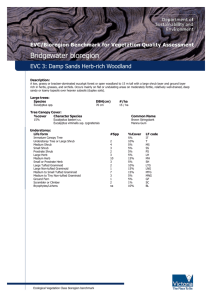Bioregional Inquiry Project
advertisement

Bioregional Inquiry Project (A Sense of Place, September 2014) The Bioregional Inquiry Project is a focused examination of the community and the region around Sterling, using some of the tools and experiences you will be exposed to during A Sense of Place. Entwined among the many pieces of A Sense of Place – the canoeing, map & compass sessions, visits to local artisans, farm tours, reading discussions, and so on – are the roots of how people relate to one another and to the world in which they live to build a sense of place. This project is a multi-part assignment that asks you 1. to explore the concept of bioregion, 2. to make ecological and cultural connections within Craftsbury’s bioregion, and 3. to consider ways to strengthen connections and communities within our bioregion. BIP 1: Defining “Bioregion.” In-class writing—to be turned in, ungraded (pass/fail). People have defined the concept of “bioregion” in different ways. On the accompanying handout, you will find five different definitions. Consider the idea of bioregion in a 1-2 page informal paper by doing the following: a) Read these different definitions; b) Discuss two of these definitions, considering what you agree and disagree with; c) Create your own 1-2 sentence definition of the term bioregion; and d) Describe the bioregion of your home. BIP II and III. Essay: The Craftsbury Bioregion. Graded 4-5 page essay. Working thesis and outline, printed copy due in class on Tuesday, September 2 (6:30). Draft of paper must be read and signed by a peer, an ASOP T.A. or member of the Writing Center prior to final submission. Final essay and signed draft due September 10th, put in the box outside of Laura Beebe’s office, 1st floor of Kane, near admissions. *Note you may submit your final papers early.* The Assignment Consider one specific person or place you visited during A Sense of Place and write a 4-5 page essay that discusses what this person or place shows us about relationships among land-use, conservation, community, and sustainability within the bioregion of the greater Craftsbury area. Important Dates _____Friday, August 29, 8:30 am, bring journals to class _____Monday, September 2, 6:30 pm, working thesis and outline, bring printed copy _____Any time before September 10, draft read and signed by a peer, an ASOP T.A. or Writing Center member ____Wednesday, September 10, signed draft and final paper due to Laura Beebe’s office BIP II. Brainstorming and Use of the Journal (Friday, Aug. 29) Please bring your journals and ideas. During this class we will analyze and decode our journals for common themes and interesting perspectives. We will then transform those ideas into a direction or two for your paper. By the time you leave this session you will be prepared to draft a working thesis and outline to bring to class on Tuesday evening. Below you will find some examples for essay topics. Examples *You might focus on Pete’s Greens and its relationship to the Black River watershed, the local economy, labor, and energy consumption. *You might focus on the botany of the cedar swamp (or the sugarbush), its relationship to other natural communities in our watershed, our use of the natural resources, and the impact of human activities. *You may pick the Lowell Mountains (where you will do your Night Hike) and its region as a place for Sterling community building, sustainable methods in maple sugaring and forest conservation. BIP III: Establishing a Structure and Outline (Tuesday, Sept 2): During this class we will explore the various ways your essay could be structured and organized. Please bring a printed copy of a working thesis and outline. Below is an example of what your easy structure might look like. Example essay structure a. Set the stage with a narrative of your experience with the person or place you are focusing on, describing relevant details of your visit. b. Use your experience to lead to your thesis (what you are saying about this person/place’s role in the bioregion). c. Demonstrate your thesis though discussion of these relationships, using specific examples from your experience and from the readings—connecting your ideas others’ words and ideas (whether agreeing, disagreeing, or refining). d. Conclude your essay by discussing the broader significance of this person or place in the greater Craftsbury bioregion as a way to consider the “so what?” of your ideas. Final Thoughts on the Essay *Note: You are expected to include at least two quotations from someone you talk with during A Sense of Place and at least one quotation or paraphrase from a reading in the A Sense of Place Reader. If using a direct quote from your reader please cite using MLA or APA format. *Note: In your discussion of relationships, be sure to include all four components listed above: land-use, conservation, community, and sustainability. *Note: You may need to do some research. You can interview faculty members, use resources in the library and/or go back to your place on your own. *Essays must be typed, 12-pt font, double spaced and include your name on the front page. *If you have a learning disability or feel that you will need additional help and/or accommodations please see the instructor as soon as possible. It is also recommended that you meet with Leland Peterson, lpeterson@sterlingcollege.edu. Sterling College is here to serve your specific learning needs in any way that we can. ***** A Note about Academic Honesty You are expected to be familiar with the Sterling College Academic Honesty Policy, found on pages 4445 of your student handbook. It reads, in part, “all students are expected to exhibit honesty in completing classroom and laboratory work. A student shall neither give nor receive unauthorized aid.” In addition, “plagiarism will not be tolerated.” If the concept or words you are using are “borrowed or copied from any source, whether electronic, print, recorded, or spoken word, the original source must be acknowledged.” If you are unsure about when and how to cite another’s ideas or words, ask one of us. Faculty Lbeebe@sterlingcollege.edu, office is 1st floor Kane









